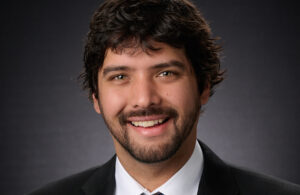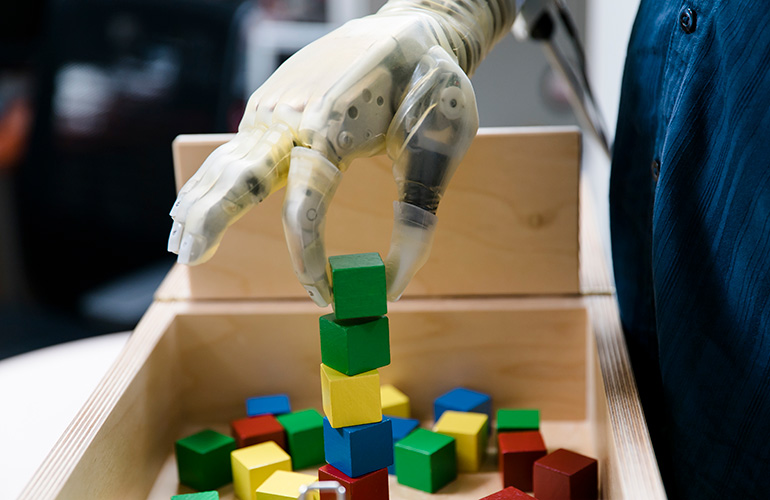
A patient controls a DEKA advanced prosthetic arm and hand using Blue Arbor’s RESTORE Neuromuscular Interface System. [Photo courtesy of Blue Arbor Technologies]
A control system breakthrough could usher in a host of advanced technologies for prosthetic limbs.
The co-founders of Blue Arbor Technologies — President Dr. Paul Cederna and Chief Technology Officer Alex Vaskov — say their RESTORE (Reimagining Engineering Solutions To Optimize Restoration of Extremities) Neuromuscular Interface System could be just the control system to make that happen.
Blue Arbor developed a way to graft muscle tissue onto a patient’s nerves to amplify the movement signals used to control their arm, wrist and hand, then tap into that muscle with implantable sensors to capture and transmit those signals.
Related: Blue Arbor goes beneath the surface for better control of limb prosthetics
They won FDA breakthrough device designation for the RESTORE system and have implanted the technology into four patients under an FDA investigational device exemption (IDE).
In an interview, Cederna and Vaskov discussed three other upper extremity prosthetic advances needed to improve devices for limb loss patients — and why they hope their system can help more patients take advantage of them.
1. Better fingertip sensors

Blue Arbor Technologies co-founder and President Dr. Paul Cederna [Photo courtesy of Blue Arbor Technologies]
Cederna: “We are already doing sensory feedback in patients, but as soon as prosthetic limbs start getting fit with better sensorized fingertips, we will have more opportunities to give naturalistic feeling. There are lots of really exciting new ways to provide different types of tactile feedback — artificial skins with sensors and things like that — and I’m really excited about all of those being developed, because all of those could get fit onto these advanced prosthetic limbs and then we can use those signals to feed back into the body to give them sensation back. Sensors in the fingertips can tell if there’s pressure on the fingertips. We can take those electrical signals, wirelessly feed them from the prosthesis to our external sensing unit, convert those signals to electrical signals, and then stimulate the same regenerative peripheral nerve interface that have sensory fibers and give them sensation back in their fingers. When we have new biologic constructs that include different biologic tissues, they are going to give us the opportunity to provide more types of sensation. As the sensors get better, our biologic constructs will be better as well, which are really going to give us the opportunity to give people feeling back. There are different fibers that detect if there’s slippage: If you have something in your hand and it starts slipping, these fast-adapting sensory nerve endings pick up that one is shutting off and one is turning on, so something must be moving through your fingers. It gives you that feedback to grab onto it more tightly if you don’t want to lose it.”
2. Better wrist actuation

Blue Arbor Technologies co-founder and Chief Technology Officer Alex Vaskov [Photo courtesy of Blue Arbor Technologies]
Vaskov: “The hands are really good — there’s newer hands that have very fast motors — elbow motors are good, but wrist motors have stayed the same for decades. And a lot of them only do rotation, which is understandable. If you’ve never had the control signals for it, why would you make it? But we’re getting to the point with the RESTORE system where you’re going to have the control signals for it, so a nice, multi-degree-of-freedom wrist is really important to position their hand to do things.”
Cederna: “There’s there’s no question about it: If I’m a prosthetic manufacturing company, I’m not making a lot of advanced prosthetic limbs if there’s no really great control strategy. Now that there is a good control strategy available, then I’m really excited because getting more degrees of freedom at the wrists and the fingers is great, longer battery power would be great, lighter devices would be great. [Our control technology] is going to drive all of that development forward. I’m so excited for patients with limb loss, because there are just so many of them. And you know, there hasn’t been any huge advance for them in a long time. So this would be great.”
3. Better software
Vaskov: “A lot of what we’ve done is linear algorithms, and they work fine because we have very independent signals. When we start talking about really complex movements and controlling those simultaneously, a lot of what we’ve been looking at in research is the use of deep learning.”

